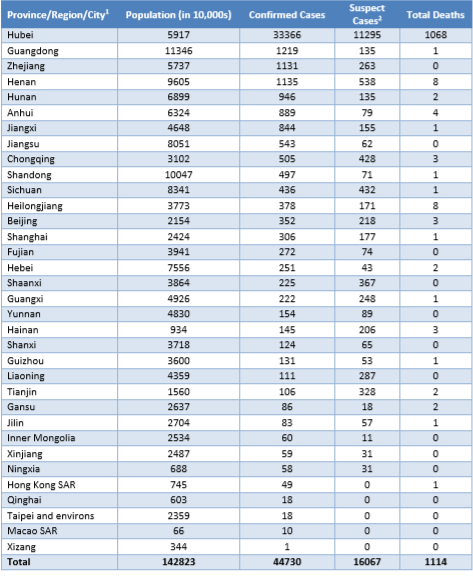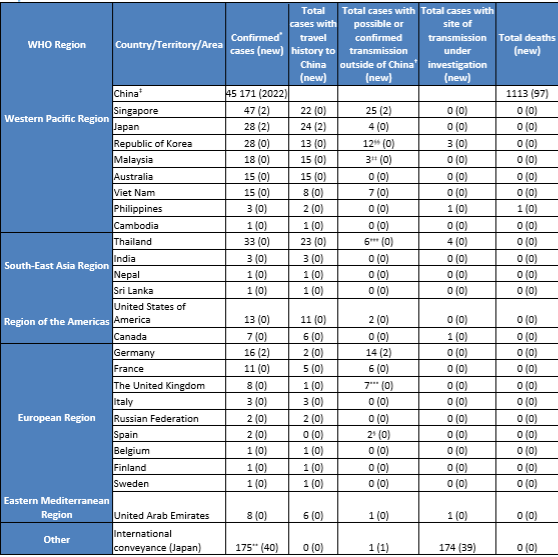Excluding China, there are 24 countries reporting cases of COVID-19. Among these 24 countries, 23 report cases with an exposure in China. In addition, 11 of these 23 countries report cases attributed to local transmission inside the reporting country. Four of the 24 countries report cases where likely exposure occurred outside the reporting country and outside of China. Among these four reporting countries the most likely countries where exposure occurred were France, Germany, Japan and Singapore (see map below). All transmissions occurred within known defined clusters.
SURVEILLANCE
Table 1. Confirmed cases of COVID-19 acute respiratory disease reported by provinces, regions and cities in China, 12 February 2020

Table 2. Countries, territories or areas with reported confirmed COVID-19 cases and deaths. Data as of 12 February 2020

Figure 2: Epidemic curve of COVID-19 cases (n=155) identified outside of China, by date of onset of symptoms and travel history, 12 February 2020

Note for figure 2: Of the 441 cases reported outside China, 16 were detected while apparently asymptomatic. For the remaining 425 cases, information on date of onset is available only for the 155 cases presented in the epidemiologic curve.
Figure 3: Epidemic curve of COVID-19 cases (n=441) identified outside of China, by date of reporting and travel history, 12 February 2020

STRATEGIC OBJECTIVES
WHO’s strategic objectives for this response are to:
• Limit human-to-human transmission including reducing secondary infections among close contacts and health care workers, preventing transmission amplification events, and preventing further international spread from China*; • Identify, isolate and care for patients early, including providing optimized care for infected patients; • Identify and reduce transmission from the animal source; • Address crucial unknowns regarding clinical severity, extent of transmission and infection, treatment options, and accelerate the development of diagnostics, therapeutics and vaccines; • Communicate critical risk and event information to all communities and counter misinformation; • Minimize social and economic impact through multisectoral partnerships.
*This can be achieved through a combination of public health measures, such as rapid identification, diagnosis and management of the cases, identification and follow up of the contacts, infection prevention and control in health care settings, implementation of health measures for travelers, awareness-raising in the population and risk communication.
PREPAREDNESS AND RESPONSE
• To view all technical guidance documents regarding 2019-nCoV, please go to this webpage.
• WHO is working closely with International Air Transport Association (IATA) and have jointly developed a guidance document to provide advice to cabin crew and airport workers, based on country queries. The guidance can be found on the IATA webpage.
• WHO has developed a protocol for the investigation of early cases (the “First Few X (FFX) Cases and contact investigation protocol for 2019-novel coronavirus (2019-nCoV) infection”). The protocol is designed to gain an early understanding of the key clinical, epidemiological and virological characteristics of the first cases of 2019nCoV infection detected in any individual country, to inform the development and updating of public health guidance to manage cases and reduce potential spread and impact of infection.
• WHO has been in regular and direct contact with Member States where cases have been reported. WHO is also informing other countries about the situation and providing support as requested.
• WHO has developed interim guidance for laboratory diagnosis, advice on the use of masks during home care and in health care settings in the context of the novel coronavirus (2019-nCoV) outbreak, clinical management, infection prevention and control in health care settings, home care for patients with suspected novel coronavirus, risk communication and community engagement and Global Surveillance for human infection with novel coronavirus (2019-nCoV).
• WHO has prepared disease commodity package that includes an essential list of biomedical equipment, medicines and supplies necessary to care for patients with 2019-nCoV.
• WHO has provided recommendations to reduce risk of transmission from animals to humans.
• WHO has published an updated advice for international traffic in relation to the outbreak of the novel coronavirus 2019-nCoV.
• WHO has activated of R&D blueprint to accelerate diagnostics, vaccines, and therapeutics.
• WHO has developed an online course to provide general introduction to emerging respiratory viruses, including novel coronaviruses.
• WHO is providing guidance on early investigations, which are critical to carry out early in an outbreak of a new virus. The data collected from the protocols can be used to refine recommendations for surveillance and case definitions, to characterize the key epidemiological transmission features of 2019-nCoV, help understand spread, severity, spectrum of disease, impact on the community and to inform operational models for implementation of
STRATEGIC OBJECTIVES
WHO’s strategic objectives for this response are to:
• Limit human-to-human transmission including reducing secondary infections among close contacts and health care workers, preventing transmission amplification events, and preventing further international spread from China*;
• Identify, isolate and care for patients early, including providing optimized care for infected patients;
• Identify and reduce transmission from the animal source;
• Address crucial unknowns regarding clinical severity, extent of transmission and infection, treatment options, and accelerate the development of diagnostics, therapeutics and vaccines;
• Communicate critical risk and event information to all communities and counter misinformation;
• Minimize social and economic impact through multisectoral partnerships.
*This can be achieved through a combination of public health measures, such as rapid identification, diagnosis and management of the cases, identification and follow up of the contacts, infection prevention and control in health care settings, implementation of health measures for travelers, awareness-raising in the population and risk communication.
countermeasures such as case isolation, contact tracing and isolation. Several protocols are available here: https://www.who.int/emergencies/diseases/novel-coronavirus-2019/technical-guidance/early-investigations
• WHO is working with its networks of researchers and other experts to coordinate global work on surveillance, epidemiology, modelling, diagnostics, clinical care and treatment, and other ways to identify, manage the disease and limit onward transmission. WHO has issued interim guidance for countries, which are updated regularly.
• WHO is working with global expert networks and partnerships for laboratory, infection prevention and control, clinical management and mathematical modelling.
RECOMMENDATIONS AND ADVICE FOR THE PUBLIC
During previous outbreaks due to other coronavirus (Middle-East Respiratory Syndrome (MERS) and Severe Acute Respiratory Syndrome (SARS), human-to-human transmission occurred through droplets, contact and fomites, suggesting that the transmission mode of the 2019-nCoV can be similar. The basic principles to reduce the general risk of transmission of acute respiratory infections include the following:
• Avoiding close contact with people suffering from acute respiratory infections.
• Frequent hand-washing, especially after direct contact with ill people or their environment.
• Avoiding unprotected contact with farm or wild animals.
• People with symptoms of acute respiratory infection should practice cough etiquette (maintain distance, cover coughs and sneezes with disposable tissues or clothing, and wash hands).
• Within health care facilities, enhance standard infection prevention and control practices in hospitals, especially in emergency departments.
WHO does not recommend any specific health measures for travellers. In case of symptoms suggestive of respiratory illness either during or after travel, travellers are encouraged to seek medical attention and share their travel history with their health care provider.
